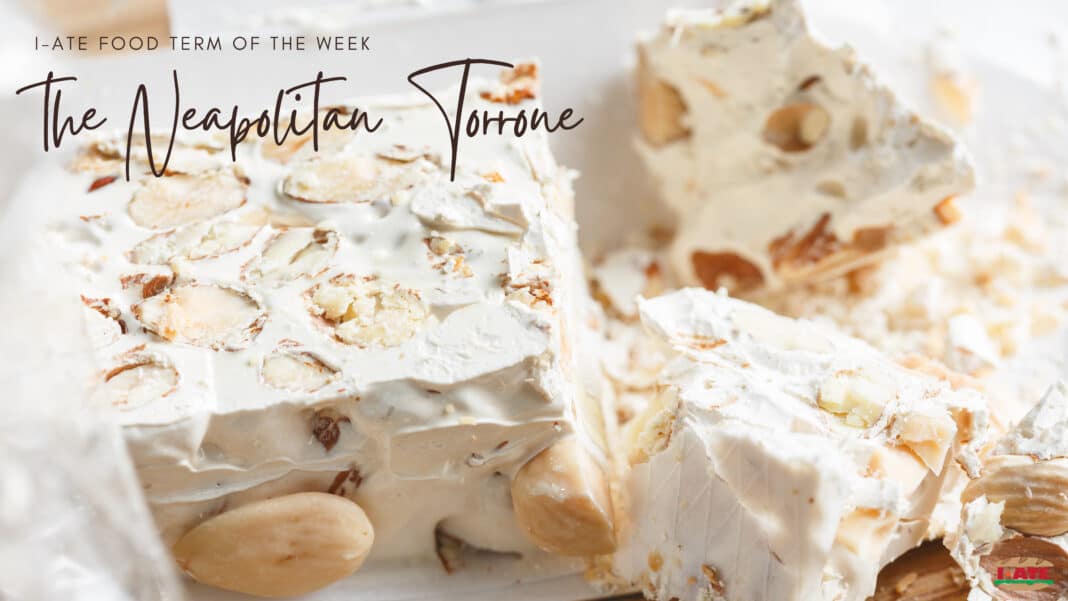‘O murticiell: the Neapolitan Torrone
Every year in the days before the 2nd of November the city of Naples, in Italy, teems with stalls selling many varieties of nougat known as torrone napoletano (Neapolitan torrone), which differs from the traditional nougat consumed all over the world.
Traditional nougat, in Italian torrone, takes its name from the Latin verb torréo, which means ‘to toast’ in relation to the dried fruit used in it. Indeed, the origins of this sweet date back to the Roman age in the Italian city of Benevento, but its evolution is strictly connected to the city of Cremona[1]. Traditional torrone is made with almonds, honey, and sugar (additionally, egg white), and is characterised by a rectangular shape that has been inherited by its Neapolitan version.
Neapolitan torrone, instead, is creamier and softer than the traditional one; it is made with cocoa as a substitute of honey. and a mix of white chocolate and nut cream. This creamy part is enriched with dried fruit, such as nuts and almonds, or candied fruit, coffee beans, puffed rice and many other ingredients, and it is covered with a harder part usually made of black chocolate. Neapolitan torrone is commonly cut into slices and served after a meal or to visiting guests during the period running from the end of October to the beginning of November.
This particular type of nougat has a gastronomic tradition that carries social and cultural associations to the mortuary cult in Naples. No wonder Neapolitan torrone is also known as torrone dei morti (literally ‘nougat of the dead’) or murticiell (the Neapolitan word for ‘the little dead’), and its history is connected to the 2nd of November, when in contemporary Western Christianity the Commemoration of All the Faithful Departed, also known as All Souls’ Day, is celebrated. The story goes that in the past torrone used to be a gift for the dead: children were chosen to bring torrone to the dead as a way of brightening their afterlife journey. Others say that torrone was placed on the graves so that the dead could come back to visit their loved ones (it was not rare to find food on the graves in the past). It is not a coincidence that Neapolitan torrone has the typical shape of a coffin[2].
Many stories have been told about the tradition of Neapolitan torrone, like that of the ghost of a glutton child who appears during this period of the year to eat torrone in one of the most famous cafés in Naples: the Gambrinus. Located between “via Chiaia” and “Piazza del Plebiscito” square, it offers different variants of torrone, including a version called Conte Dracula, which is covered with dark chocolate and filled with almonds and a red cream. Different flavours can also be found at Carraturo bakery, on “via Casanova”, among which a variant of the traditional hard nougat with honey, almond and black pepper. Other bakeries, saloons and chocolate shops such as Gay Odin and Gallucci sell torrone for all tastes. One thing is sure: no matter where you buy it, no doubt you’ll lick your fingers.
[1] https://www.tartufidolci.it/citta-torrone-benevento-cremona-grinzane/.
[2] https://www.osteriadacarmela.it/2017/10/31/murticciell-la-tradizione-del-torrone-dei-morti-napoli/.
References
O Murticciell, la tradizione del Torrone dei Morti a Napoli. 2017. Osteria da Carmela. [ONLINE]
Available at: https://www.osteriadacarmela.it/2017/10/31/murticciell-la-tradizione-del-torrone-dei-morti-napoli/
[Accessed 26 November 2020].
La leggenda della bambina fantasma al Gran Caffè Gambrinus. 2017. Gran Caffè Gambrinus. [ONLINE]
Available at: https://grancaffegambrinus.com/la-leggenda-della-bambina-fantasma-al-gran-caffe-gambrinus/
[Accessed 26 November 2020].
La leggenda della bambina fantasma al Gran Caffè Gambrinus. 2017. Gran Caffè Gambrinus. [ONLINE]
Available at: https://grancaffegambrinus.com/la-leggenda-della-bambina-fantasma-al-gran-caffe-gambrinus/.
[Accessed 26 November 2020].
https://www.napolidavivere.it/ [Accessed 26 November 2020].
http://en.flamigni.it/passions/nougat-history [Accessed 26 November 2020].
Written by Emanuela Ammendola,
PhD student in “European Languages and Specialized Terminology”at the University of Naples “Parthenope”.

